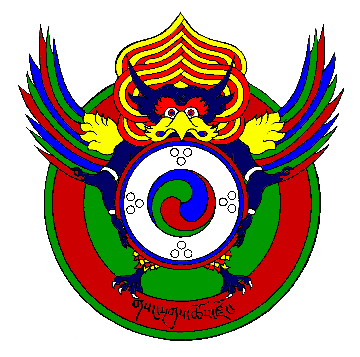
The Dzogchen Garuda
The Emblem of the Aro gTérma Cycles
The emblem of the Confederate Sanghas of Aro is the Garuda holding the wisdom mirror. The Garuda which symbolises Dzogchen is inextricable from the name of the Lady gTértön who discovered the Aro gTér: Khyungchen Aro Lingma (Khyung chen A ro gLing ma, 1886-1923). Khyung means Garuda and chen means great – so Khyungchen Aro Lingma means The Great Lady Garuda who tastes the Primordial A. The Garuda is born spontaneously from its egg and is immediately in full flight in the same way that the Dzogchen yogi or yogini discover themselves born spontaneously into the primordial state.
At the centre of the wisdom mirror (ye shes me long) is the gakyil (dGa dKyil), the circle of joy whose swirling blue, green and red sections symbolise Dang, Rolpa, and rTsal (mDangs, rol pa, and rTsal); the three aspects of realised energy.
At each of the four cardinal points of the wisdom mirror are found three circles which describe Dang Rolpa and rTsal as manifesting through the four means of establishing existential confidence (sKyab) in Sang-gyé, Chö and Gendün; Lama, Yidam, and Khandro-pawo; rTsa, rLung, and Thig-lé; and in Ngo-wo, Rang-zhin, and Thug-jé.
The wings of the Garuda have nine sections which symbolise the nine skies and the nine bardos. The two horns of the Garuda impale duality without effort, and the two talons hold to the intrinsic spaciousness of the nature of Mind.
The Tibetan umé script in the outer circle of the emblem are the words Sang-ngak-chö dzong (gSang sNgags chos rDzong), which is the name that Kyabjé Düdjom Rinpoche gave to Ngak’chang Rinpoche and Khandro Déchen for the establishment of the gö-kar chang-l’i dé (gos dKar lCang loi sDe) in the West.
